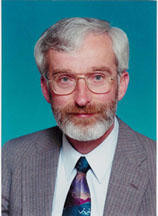
Goddard Space Flight Center, Greenbelt, Maryland 20771
ENGINEERING COLLOQUIUM
Monday, May 15, 2006 / 3:30 PM, Building 3 Auditorium

Alex Hills
"Wi-Fi and Beyond"
ABSTRACT -- People love Wi-Fi. They use it in Starbucks, in airports and in their homes, and it's easy to see why Wi-Fi is so popular. The technology allows "anytime-anywhere" access to the Internet. It provides high-speed connections that allow email messages to appear almost instantly and Web pages to paint a computer's screen quickly -- all with the same mobility and freedom that have made cell phones so popular. But the popularity of Wi-Fi can cause problems for Wi-Fi users. As Wi-Fi networks became more heavily used, they may be unable to handle the load, and, as these networks bog down, users can notice slower service and longer delays.
Some of these problems were evident even in 1993, when I led a team at Carnegie Mellon University to build Wireless Andrew, the first large-scale wireless LAN and the precursor to today's Wi-Fi networks. Now, thirteen years after the inception of Wireless Andrew, Wi-Fi has become extremely popular, and the technology is changing in order to keep up with this popularity. In this talk I describe Wi-Fi's latest woes and the ways that the newest Wi-Fi technology tries, in spite of these woes, to keep up with performance expectations. I also describe some other technologies, like WiMAX, and how these are likely to impact the wireless landscape.
SPEAKER -- Alex Hills went to Alaska in 1970 to work on building a series of public radio stations to provide the first broadcast service in the far reaches of the remote state. Within a few years he had worked on building a number of stations, he had managed two of them, and he was known to rural Alaskan radio listeners as "Alex in the Morning." But he continued to serve the people of the Alaska "bush" through his work in using small satellite earth stations to provide telephone and television service, and he continued his involvement in building and improving Alaska's telecommunications network for many years, living and working in Eskimo villages and other small communities.
In 1992 Dr. Hills joined Carnegie Mellon University as Distinguished Service Professor. He served the university from 1995 to 1999 as Vice Provost and Chief Information Officer, and he was founding director of Carnegie Mellon's Information Networking Institute. He conceived and founded the Wireless Andrew project in 1993. Wireless Andrew is a campus-wide, high-speed wireless network available to all students, faculty and staff. It was the first network of its kind and has been a model for many other universities and businesses. Dr. Hills is an avid runner, backpacker, and cross-country skier.